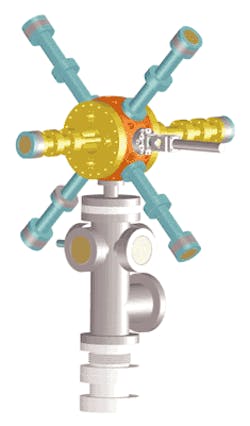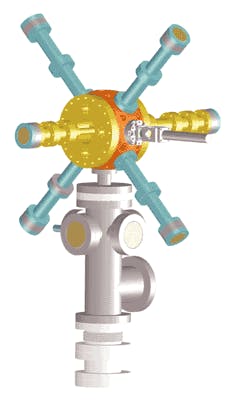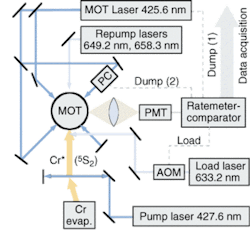Optical feedback system produces single atoms on demand
As nanotechnologists narrow their sights from tens of nanometers to the atomic level, the notion of doing predictable things with single atoms increases in importance. Predictability in an atomic-sized world full of statistical quantum events can be hard to come by, however. So researchers at the National Institute for Standards and Technology (NIST; Gaithersburg, MD) have devised a feedback system that allows a magneto-optical trap (MOT) to produce atoms on demand by effectively squeezing the randomness out of traditional MOT load and loss processes. 1
Because magneto-optical trapping essentially involves pushing atoms with opposing laser beams, the atoms actually fluoresce in the process. And that fluorescence provides the feedback signal that the NIST team uses to trap one and only one atom. "Surprisingly enough, a single atom can give us a photon count rate of about 3000 photons per second, which is a pretty good-sized signal," said NIST physicist Jabez McClelland.
"It's kind of like a thermostat in a house, and we have a little level that we set on the fluorescence, which is coming out in steps," he continued. "It's pretty clear whether there is one or zero atoms. And if the fluorescence falls below our thermostat setting we open up the loading and let more atoms in. If it ever goes above that threshold, we shut it off."
The probability of finding a single atom in the trap at any time is almost 99%. But to achieve that, McClelland and postdoctoral coworkers Shannon Hill and Marin Pichler had to design sufficient background suppression into the optical system. Even though the count rate for a single atom is 3000 photons a second, each of the six laser beams that form the optical portion of the magneto-optical trap generates about 20 orders of magnitude more photons than the atom and all at the same wavelength. So a high-resolution fluorescence detector had to be designed with a very small aperture and meticulous masking out of scattered light. "We also spent a lot of work on the chamber, making baffles, tilting the input windows, and that sort of thing to suppress the background," he said.
Six laser beams generated by an ultraviolet-pumped dye laser enter the MOT through antireflection-coated viewports located on long arms tilted 5° off normal and coated with blackened, cone-shaped baffles to trap retroreflected light (see Fig. 1). A viewport on the MOT with a solid angle of 0.2 steradians collects the chromium fluorescence for fourfold magnification in a pair of achromatic doublet lenses and imaging onto a 0.2-mm aperture. The 425.6-nm fluorescence then passes through an optical bandpass filter centered on 425 nm for detection with about 16% quantum efficiency by a low-dark-count single-photon-counting photomultiplier with a sodium potassium photocathode.1
FIGURE 2. A schematic shows four of the six MOT laser beams. A pump laser can prevent loading by pumping atoms into a metastable state, or loading can be initiated by pumping atoms back into their ground state using a load laser through an acousto-optic modulator. Repump lasers prevent trap loss to the metastable state. The trap can be dumped either through shifting the MOT laser off resonance or blocking one MOT beam with a Pockels cell while pulsing the magnetic field. Atomic fluorescence is read through a photomultiplier.
The loading process that this feedback system controls relies upon laser pumping to condition atoms prior to entering the trap (see Fig. 2). "We can optically pump atoms into a metastable state that prevents them from getting trapped as they fly through, or we can optically pump them back into the ground state, which allows them to get trapped," McClelland said. The system is dumped by either momentarily shifting the laser frequency slightly above resonance or pulsing the magnetic field while pumping one of the MOT lasers with a Pockels cell.
Improvements
A primary goal for improving the technique, which has so far been demonstrated at 10 atoms per second, is to make it faster. One way of doing that would be to actually speed up the atoms as they fly through the trap; another would be to increase the efficiency of fluorescence detection. The 3000 photons a second that the system currently detects for each atom is about four orders of magnitude less than the total fluorescence emitted per atom in all directions.
The NIST experiment was performed on chromium atoms, but McClelland said that it should be possible to perform it on any atom that can be cooled and trapped, and that continuing improvements in laser technology are making an ever-increasing range of atomic species available for such cooling and trapping processes.
"For a long time, laser coolers and trappers could only do basically the alkali atoms such as sodium, rubidium, and cesium, but people have now demonstrated these sorts of effects in metastable rare gases, aluminum, and chromium," he said. "A group in The Netherlands is working on iron, and strontium is another possibility. As laser technology has improved, especially into the near ultraviolet, many possibilities for new atoms have opened up. Also, elements like gallium and indium are being worked on and those have implications in the semiconductor industry."
In addition, even though the NIST experiment was motivated by interest in nanotechnology, the ability to control single atoms could also have potential ramifications in other fields, such as quantum computing and electrodynamics. "There are a lot of quantum electrodynamics that one could study if you had just a single atom sitting in an optical cavity with a strong coupling between the atom and the cavity," he said.
REFERENCE
- S. B. Hill, J. J. McClelland, Appl.Phys.Lett. 82(18) 3128 (May 5, 2003).


